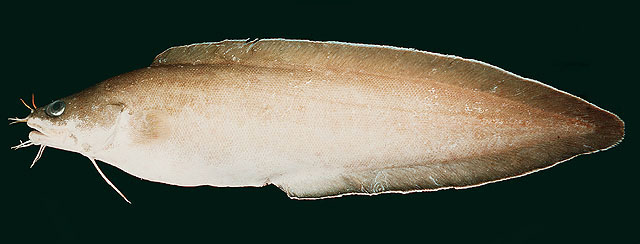| Ophidiidae (Cusk-eels), subfamily: Brotulinae |
| 100 cm TL (male/unsexed) |
|
reef-associated; marine; depth range 1 - 650 m |
| Indo-Pacific: Red Sea and East Africa to Pitcairn, north to southern Japan, south to Lord Howe Island. Also reported from Persian Gulf (Ref. 68964). |
|
Dorsal spines (total): 0-0; Dorsal soft rays (total): 109-139; Anal spines: 0-0; Anal soft rays: 80-106. In addition to meristic counts, B. multibarbata differs from B. townsendi by possessing a larger eye (width>interorbital space) and having slightly different coloration (dark brown with a submarginal black band and narrow white border on the dorsal and anal fins versus greenish to orange brown with orange-bordered dorsal and anal fins).
Description: Characterized by grey to brownish color grading to white on abdomen and lower head; small juvenile translucent with dark grey spots; longitudinal scales 144-181; three pairs of barbels on snout; three pairs of barbels on chin; body depth 4.4-7.0 in SL (Ref. 90102). |
| Benthopelagic on shelf and upper slope (Ref. 34024). Larvae found in the epipelagic far offshore (Ref. 34024). Found in shallow lagoon and seaward reefs and occurs at depths of at least 220 m. Adults (30-90 cm) move to depths of 100-650 m (Ref. 58472). A nocturnal species, rarely seen for it lives in caves and crevices during the day and periodically emerges from cover at night to feed on crustaceans, mainly crabs, and fishes. Oviparous, with oval pelagic eggs floating in a gelatinous mass (Ref. 205). Utilized fresh and eaten steamed, pan-fried and baked (Ref. 9987). Also Ref. 58302. |
|
Least Concern (LC); Date assessed: 13 August 2019 Ref. (130435)
|
| harmless |
|
Source and more info: www.fishbase.org. For personal, classroom, and other internal use only. Not for publication.

